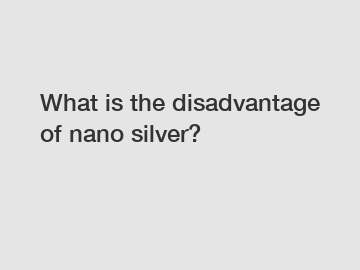What is the disadvantage of nano silver?
Nano silver has gained popularity in recent years for its antimicrobial properties, making it a popular choice for a wide range of products such as clothing, food packaging, and even medical devices. However, despite its versatility and effectiveness, there are some significant disadvantages to using nano silver that should not be overlooked.
One of the main disadvantages of nano silver is its potential toxicity to humans and the environment. While silver has long been used as an antimicrobial agent in various forms, including colloidal silver and silver nitrate, the nano-scaled particles used in nano silver products have raised concerns about their safety. Studies have shown that nano silver particles can accumulate in the body over time, leading to potential health risks such as skin irritation, respiratory problems, and even organ damage. Additionally, nano silver has been found to have negative effects on the environment, potentially harming aquatic life and impacting ecosystems.
Another disadvantage of nano silver is its potential for developing antibiotic resistance. In recent years, the rise of antibiotic-resistant bacteria has become a major concern for public health, leading to the need for alternative antimicrobial agents such as nano silver. However, prolonged and widespread use of nano silver could potentially lead to bacteria developing resistance to it, rendering it ineffective in fighting infections. This could have serious implications for the future of healthcare and the treatment of infectious diseases.

In addition to potential toxicity and antibiotic resistance, another disadvantage of nano silver is its impact on the natural microbial ecosystem. While nano silver is effective at killing harmful bacteria, it can also harm beneficial bacteria that are essential for maintaining a healthy microbiome. Disrupting this delicate balance of microorganisms in the body could have negative effects on human health, potentially leading to digestive problems, immune system disorders, and other health issues.
Furthermore, the use of nano silver in consumer products raises concerns about its long-term environmental impact. Due to its small size and durability, nano silver particles can easily enter the environment through wastewater and household waste, leading to potential contamination of water sources and ecosystems. Once released into the environment, nano silver can persist for long periods of time, further raising concerns about its potential effects on wildlife and ecosystems.
Despite its disadvantages, nano silver continues to be widely used in consumer products due to its effectiveness as an antimicrobial agent. However, it is important for consumers to be aware of the potential risks associated with nano silver and to weigh them against the benefits when choosing products that contain this ingredient. Additionally, more research is needed to better understand the long-term effects of nano silver on human health and the environment, as well as to develop safer alternatives for antimicrobial protection.
In conclusion, while nano silver offers many advantages as an antimicrobial agent, it is important to consider the potential disadvantages associated with its use. From toxicity and antibiotic resistance to its impact on the natural microbial ecosystem and the environment, there are several factors that should be taken into account when using nano silver in consumer products. By staying informed and making conscious choices, consumers can help mitigate the risks associated with nano silver while still enjoying its benefits.
If you are looking for more details, kindly visit Nano Silver in Antimicrobial Paints for Sale, nano silver antibacterial powder, Nano Silver in Antimicrobial Paints for Sale.
152
0
0


Comments
All Comments (0)